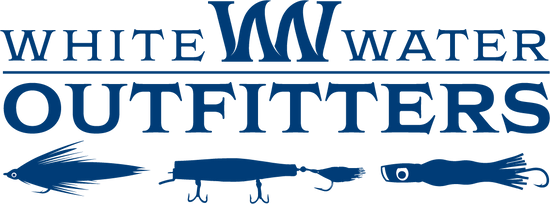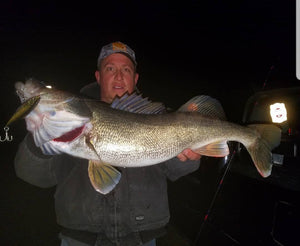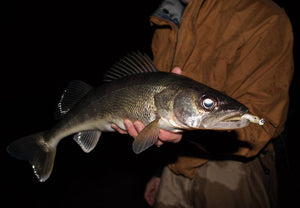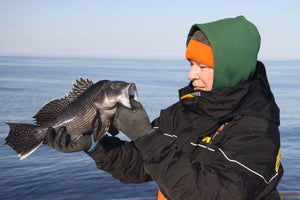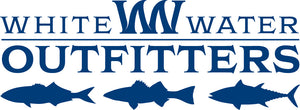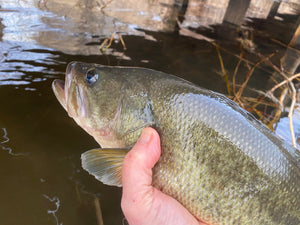Cracking The Inlet Code, Part I

It’s no secret that serious inshore predators like striped bass, bluefish, false albacore and even fluke recognize inlets as presenting excellent feeding opportunities. Indeed, many experienced local surfcasters spend a significant amount of their time probing these areas throughout the season in hopes of connecting with true trophies and maybe even their biggest fish of the year.
Like any other kind of piscatorial pursuit, there are some basics that apply to inlet fishing, and keeping them in mind can go a long way toward improving your success. Fishing optimum inlet tides, understanding jetty structure, and having suitable tackle are three of those keys, so let’s break them down.
Time The Tides
 Big bluefish often move through Shinnecock inlet in droves. They will readily strike a bucktail, or occasionally topwater plugs when they're feeding higher in the water column. OutdoorTom.com Photo.
Big bluefish often move through Shinnecock inlet in droves. They will readily strike a bucktail, or occasionally topwater plugs when they're feeding higher in the water column. OutdoorTom.com Photo.
Even more so than inside the bays, timing the tides is vital when it comes to tilting the odds in your favor when working an inlet. Both Shinnecock Inlet, only a few miles from our Whitewater Outfitters shop in Hampton Bays, and Moriches Inlet to the west, are fairly large passes where the action can differ substantially from one tidal stage to the next.
Both of these inlets, for example, drain shallow bay flats. That means on a strong ebb, especially during full and new moon phases, entire schools of baitfish can get sucked out of the bay, flushed out the ocean end of the inlet, and pushed out to sea or into the adjacent ocean surf if the wind is blowing onshore.
The reverse is true for flooding tides. These see baitfish pulled into the inlet as they try to cross its path along the ocean front. After a tiring battle with the current during which they are extremely venerable to predation, these baitfish are eventually deposited on the bay side structure, where more predators take advantage of their disorientation and attempts to reschool.
As a general rule, the first hour or two of moving water in either direction are good slots for inlet prospecting - but you can narrow it down further. During the spring and early summer, ebbing tides tend to be the most productive because they carry bay-warmed water through the inlet and toward the ocean. In mid- to late-summer the reverse is true, with cool and refreshing incoming ocean water pushing over the bay flats to refresh the bite.
Come the fall, prime time at the inlets tends to shift back to the ebb as thick schools of baitfish, snappers, young-of-the-year weakfish and various juveniles race for the ocean to begin their southward migrations. This creates a super-charged living chum slick that spills down the beach igniting the fall run.
Of course, a decent bite can occur on any tide based on various conditions but the general guideline of ebb tides in the spring, flood tides in the summer, and ebbs again in the fall are usually solid starting points for testing the inlet bite.
Scout The Structure

The constant flow of baitfish in and out of inlet areas certainly is a powerful drawing card, but so is the ability of strong inlet currents to slice through sandy bottoms creating cuts, bars, troughs, deep channels and holes. Additionally, rapid changes in inlet depths also create rips and eddies, often in quick succession, providing anglers with varied opportunities to explore over a relatively short area. Bends in the inlet create points and coves where gamefish can stack up and use their size and strength to slice through schools of smaller critters until so full they heave their meals from the mouth while being beached by lucky surfcasters.
Fluke are particularly fond of setting up in inlet rips and holes. They’ll settle in the lee between small bars or humps on the bottom where the water on a running tide is deflected upward. As the water rips over the bar, baitfish sense the quiet below and dive for the bottom. A generous number of them end up in the gullets of the keeper flatties that lay in wait.
Shoreline rip-rap and jetty rocks provide another kind of structure that lends itself well to solid catches. Generally designed to discourage erosion, they provide breaks in the shoreline contour plus mussel-lined nooks and crannies for baitfish to investigate. Add in their current deflection ability that can confuse baitfish and ignite the fiery competitiveness of the largest predators and it’s little wonder these places are often favored by sharpies.
Some inlets also feature a deep hole or two near their entrance and exits, and these often hold the biggest game fish throughout a tide. Big bass and weakfish seek out these holes and sulk down deep, often holding only a foot or so off the bottom. Here, they’ll occasionally move about to gobble up a porgy, sea bass, small fluke or other bottom scavenger that’s probing the depths for an easy meal.
In Part 2, we’ll cover a little more on inlet structure before diving into tackle and lure selection as well as inlet safety advisories.
- Bryce Poyer
